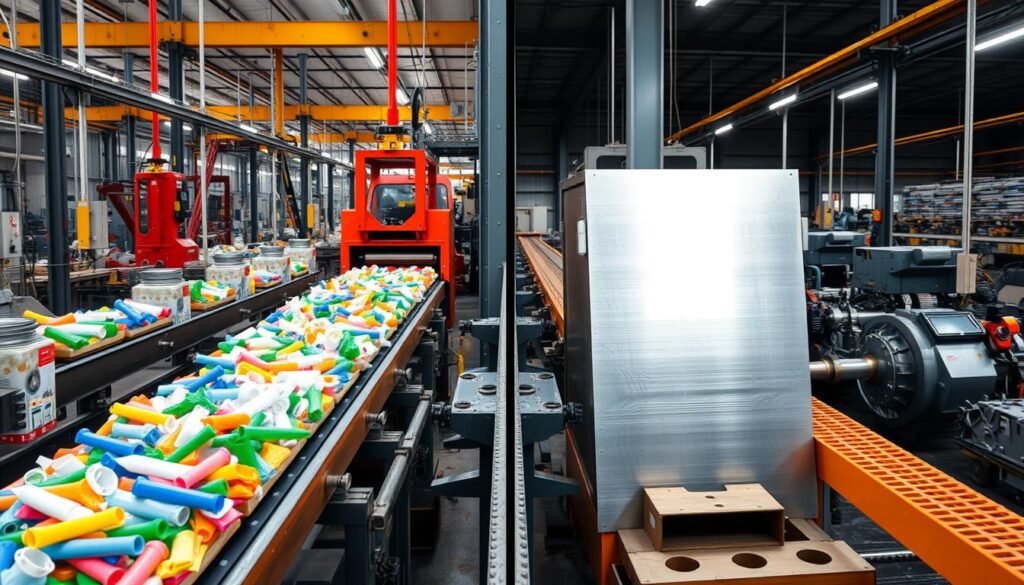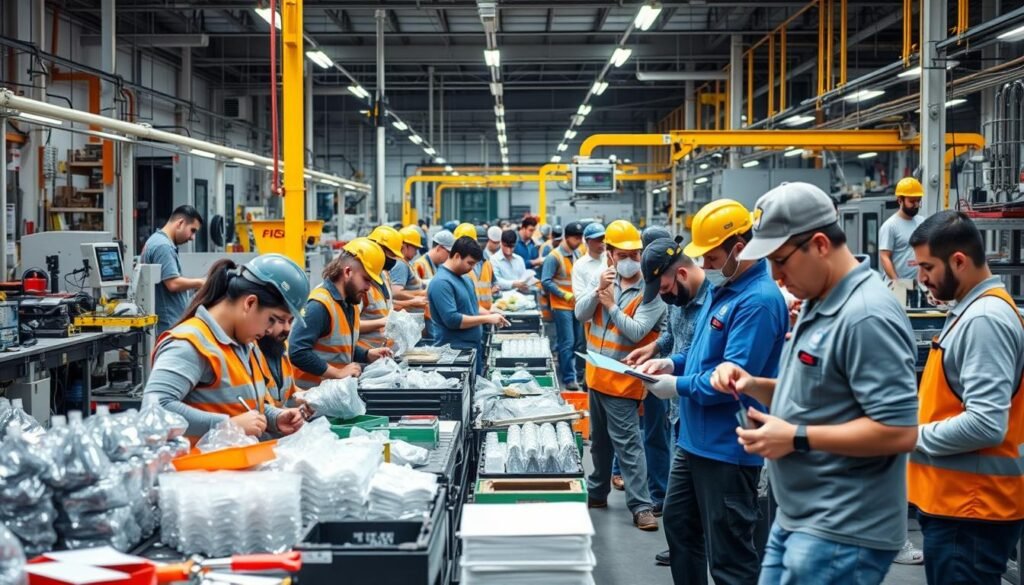Understanding plastic and aluminum production is key for businesses looking to save money. The costs of materials and production keep changing. This makes it hard for manufacturers to pick the best option.
Choosing between plastic and aluminum is a big decision for manufacturers. It’s not just about the cost of raw materials. There are many other factors to consider that affect the overall cost.
Plastic is great for making things light and flexible. Aluminum is strong and durable. Companies need to think about what they need most to make the right choice.
Key Takeaways
- Production costs vary significantly between plastic and aluminum materials
- Material selection impacts overall manufacturing economics
- Comprehensive cost analysis requires examining multiple factors
- Each material presents distinct manufacturing advantages
- Industrial needs dictate optimal material selection
Raw Material Costs: Understanding the Basics
Understanding raw material prices is complex. It involves knowing the market well. Companies making plastic resins and aluminum alloys face big challenges. They must deal with changing global economic conditions.
The raw material market is very volatile. Prices change a lot because of many factors. These factors can greatly affect how much it costs to make things.
Price Fluctuations in Global Markets
Global market changes cause raw material prices to shift unpredictably. Several things can influence these changes, including:
- Geopolitical tensions
- Economic policy changes
- International trade regulations
- Supply chain disruptions
Supply Chain Factors
Supply chain issues can really impact raw material costs. Companies need strong plans to handle these risks.
| Material Type | Average Price Volatility | Key Supply Chain Risks |
|---|---|---|
| Plastic Resins | 15-25% | Petroleum price fluctuations |
| Aluminum Alloys | 10-20% | Mining production constraints |
Material Grade Variations
Prices vary based on material grade. High-performance grades usually cost more. But, standard grades are cheaper.
“Understanding material grade nuances is crucial for effective cost management in manufacturing.” – Manufacturing Insights Report
For effective cost management, strategic sourcing and constant market analysis are key.
Manufacturing Processes for Plastic and Aluminum
Manufacturers use many ways to turn raw materials into finished goods. Injection molding and die casting are key for making plastic and aluminum parts today.
Plastic fabrication includes several important methods that affect costs:
- Injection molding: Great for making lots of plastic parts
- Extrusion: Best for long, uniform plastic profiles
- CNC machining: Offers precision for complex designs
Aluminum forming also has its own challenges:
- Die casting: Makes detailed metal parts with high accuracy
- CNC machining: Allows for precise aluminum parts
- Aluminum extrusion: Creates consistent metal shapes
“The right manufacturing process can dramatically reduce production expenses while maintaining product quality.” – Manufacturing Engineering Journal
Each method has its own benefits in cost, speed, and material use. Choosing the best method depends on the project’s needs, how many parts are needed, and how complex they are.
| Process | Material | Cost Efficiency | Production Speed |
|---|---|---|---|
| Injection Molding | Plastic | High | Fast |
| Die Casting | Aluminum | Moderate | Medium |
| CNC Machining | Plastic/Aluminum | Low | Slow |
Knowing these manufacturing methods helps businesses make smart choices. They can balance cost, quality, and efficiency in their production plans.
Energy Consumption in Production
Manufacturing plastic and aluminum uses a lot of energy. Looking at how much electricity they use and how they manage heat gives us important info. This info helps us understand costs and how green they are.
The way energy is used in making plastic and aluminum is very different. This affects how much it costs and how much carbon is released.
Electricity Requirements
Electricity is a big part of what makes things expensive in manufacturing. Each way of making something needs its own amount of energy:
- Aluminum production needs about 15-20 kWh per kilogram
- Plastic making uses around 5-8 kWh per kilogram
- Using better materials means using more electricity
Heating and Cooling Costs
Keeping things at the right temperature is key to making things green. Both materials need a lot of heat and cooling:
- Aluminum melts at over 660°C
- Plastic needs 200-300°C
- Using better cooling systems saves energy
“Energy efficiency isn’t just an environmental concern—it’s a critical economic strategy.” – Manufacturing Engineering Journal
Environmental Impact Considerations
Companies are working hard to cut down their carbon footprint. They’re using new ways to manage energy. Choosing materials that use less energy is a big plus.
New tech is coming that will cut down on electricity use. It will also make making things more efficient.
Is it Cheaper to Create a Plastic Product or Aluminum

Choosing between plastic and aluminum for manufacturing depends on many factors. We need to look at the costs of making each material. This helps us decide which is more cost-effective.
Plastic is often cheaper to start with, but aluminum lasts longer. This makes aluminum a better choice for some projects.
- Plastic production costs range from $1.50 to $3.00 per unit
- Aluminum manufacturing expenses typically span $4.00 to $7.50 per unit
- Material selection depends on project-specific needs
“The true cost of manufacturing extends beyond raw material prices — it’s about total economic impact.” – Industrial Manufacturing Quarterly
When choosing materials, consider a few things:
- How many you need to make
- What the product should be like
- How long it should last
- Its impact on the environment
| Factor | Plastic | Aluminum |
|---|---|---|
| Initial Production Cost | Lower | Higher |
| Durability | Medium | High |
| Recycling Efficiency | Moderate | Excellent |
Manufacturers should think about their costs carefully. Plastic might be cheaper at first, but aluminum could be better in the long run for some projects.
Equipment and Tooling Investment Analysis
Choosing the right manufacturing equipment is key for businesses making plastic and aluminum products. The cost of the machinery affects how well you can make things and your long-term expenses.
Companies need to think about the full financial impact of their equipment choices. The cost of tooling can greatly affect your production plan and if it’s worth it financially.
Initial Setup Costs
The cost to start making things varies a lot between plastic and aluminum:
- Plastic injection molding machines cost between $50,000 and $250,000
- Aluminum die casting equipment costs $100,000 to $500,000
- Special tooling can add 20-40% more to the cost of the equipment
Maintenance Requirements
Keeping your machines running is an ongoing cost that affects how well you can make things. Different materials need different care:
- Plastic machines need regular cleaning and parts replaced
- Aluminum machines need precise calibration and heat control
- Annual maintenance costs are usually 5-10% of the equipment’s value
Production Speed Comparison
“Speed and efficiency determine the true value of manufacturing equipment investments.” – Manufacturing Engineering Association
How fast you can make things differs between plastic and aluminum:
- Plastic injection molding: 10-120 parts per minute
- Aluminum die casting: 3-50 parts per minute
- Using automated systems can greatly boost your production speed
Choosing the right equipment is about balancing the upfront cost, maintenance, and how fast you can make things. This helps you make the most of your manufacturing setup.
Labor Costs and Skill Requirements

The world of making plastic and aluminum needs special skills. Trends in the labor market show how important skilled workers are. This affects how much it costs to run a factory.
When looking at jobs and training, manufacturers face several key points:
- Technical skill complexity for aluminum production
- Precision requirements in plastic manufacturing
- Advanced machinery operation competencies
- Safety protocol understanding
Skilled labor is a big advantage in today’s factories. The cost of training workers can greatly affect how much it costs to make things.
“The right talent transforms manufacturing from a process into a strategic capability.” – Manufacturing Workforce Institute
Different factories need different skills. Making aluminum needs more training, but making plastic is easier to get into.
| Manufacturing Type | Average Training Cost | Skill Complexity |
|---|---|---|
| Aluminum Production | $5,200 | High |
| Plastic Manufacturing | $3,100 | Medium |
It’s crucial for companies to invest in their workers. This helps them make the most of their jobs and keep costs down.
Production Volume Considerations
Understanding how much to produce is key for makers choosing between plastic and aluminum. The world of making things needs smart choices that mix how much to make with keeping costs down.
Manufacturers need to pick the right way to make things. They must think about how flexible and cost-effective their methods are.
Economies of Scale
Big production volumes are often cheaper. This is because making more things at once can save money in several ways:
- Less waste of materials
- More efficient use of equipment
- Better use of workers
- Lower costs for overhead
Minimum Order Quantities
Custom orders make things tricky. Makers must find a balance between making a lot and being flexible to stay ahead.
| Production Type | Cost Efficiency | Scalability |
|---|---|---|
| Small Batch | Higher per-unit cost | Limited |
| Medium Batch | Moderate cost | Moderate |
| Large Batch | Lower per-unit cost | High |
Production Flexibility
Today’s making needs to be adaptable. Flexible manufacturing systems help companies switch easily between different amounts and types of products.
“Adaptability is the key to surviving in today’s competitive manufacturing environment.” – Manufacturing Industry Expert
Smart makers use new tech to make production quick and flexible. This way, they can handle both custom orders and big batches well.
Recycling and Sustainability Impact on Costs
The circular economy is changing how materials are made, especially in plastic and aluminum. Recycling is key to lowering costs and environmental harm.
Choosing sustainable materials is now a big deal. Aluminum is a top pick because it’s very recyclable. It only needs 5% of the energy to make from recycled materials. This makes recycling aluminum much cheaper than many other materials.
“Eco-friendly production is not just an environmental choice, but an economic strategy,” says industrial sustainability expert Dr. Sarah Reynolds.
- Aluminum can be recycled indefinitely without quality loss
- Plastic recycling technologies are improving but face more challenges
- Material recovery rates differ significantly between materials
Eco-friendly production is shaping how companies make decisions. The cost savings from recycling are clear:
| Material | Recycling Energy Savings | Recovery Potential |
|---|---|---|
| Aluminum | 95% | Nearly 100% |
| Plastic | 60-70% | Variable |
Companies see that investing in the circular economy saves money in the long run. The upfront cost of recycling technology is worth it. It cuts down on raw material costs and boosts sustainability.
Conclusion
Understanding production cost analysis is complex. It involves looking at many factors. When deciding between plastic and aluminum, businesses must consider more than just price.
They need to think about raw material costs, energy use, equipment, and long-term plans. A good guide for choosing materials shows that there’s no one-size-fits-all solution.
Plastic might be cheaper for small batches, while aluminum is better for large ones. The right choice depends on the industry, product design, and where it’s made.
When comparing costs, each project is unique. Things like how much is made, equipment, labor, and recycling options matter a lot. Teams must analyze these carefully.
Choosing materials wisely means looking at both technical and financial aspects. This way, companies can make smart choices. They can cut costs and stay ahead in the market.
